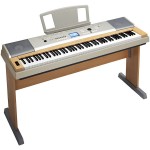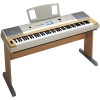“Dad! We can’t hear the TV!”
“Be quiet, you’ll wake the kids!”
“That sounds terrible!”
In the week or two after our Baldwin acoustic piano moved in, those were some of the phrases I heard from the family. See, no one else wanted to play the old piano, but I was hooked. Unfortunately, the instrument was loud (or maybe I had no soft touch), out of tune, and I had a small child who went to bed early. I guess a child going to bed early is not really unfortunate, but it made it tough to practice late in the evening!
So, what to do? I searched the Internet and found the solution – a digital piano. Five years ago I can’t really say I knew there was a class of instruments called digital pianos. Sure, I knew there were keyboards and synthesizers – I did grow up in the ’80’s and who doesn’t love the keyboard solo in On the Loose by Saga?
[embedplusvideo height=”365″ width=”450″ standard=”http://www.youtube.com/v/0PvQskY8QHo?fs=1″ vars=”ytid=0PvQskY8QHo&width=450&height=365&start=&stop=&rs=w&hd=0&react=1&chapters=¬es=” id=”ep5812″ /]
Turns out, though, there is a huge difference in regular “keyboards” and digital pianos. Sure, they both have keys, but a digital piano has weighted keys, just like a regular acoustic piano. A keyboard doesn’t. Ahhh. I didn’t know that. Even after I understood that, I still made a critical mistake. I actually bought a keyboard first and not a digital piano. A keyboard was cheaper, smaller and lighter, and I thought I’d be OK. After all, I had the acoustic to practice on as well. I just wanted to practice the notes. After a few weeks with the keyboard, I realized that was a mistake. Notes were not enough. I needed the more realistic feel provided by weighted keys.
 I won’t go into all the research and comparisons I went through, but I ended up buying a Yamaha YPG-625. Besides eventually going to a teacher, that purchase is one of the biggest reasons I progressed as far as I have.
I won’t go into all the research and comparisons I went through, but I ended up buying a Yamaha YPG-625. Besides eventually going to a teacher, that purchase is one of the biggest reasons I progressed as far as I have.
Having a digital piano solved all my problems I mentioned at the top of this post. First, a digital piano has volume control and a headphone jack. This let me practice without the family hearing me and me hearing them. Win-Win. Second, the DP is always in tune. When I choose to play without headphones, the family could still tell me it was terrible, but at least I was in tune.
Some additional features have also been useful. First, it has a built in metronome. If you don’t know, a metronome is a device that provides an adjustable beats per minute click to allow you to practice tempo. This is a indispensable and probably underused tool for any musician. The digital also has the ability to record what I’m playing and let me transfer it to a computer to play back. Listening to your own recording is extremely helpful – and humbling. Finally, there a a couple hundred different “voices” built in, allowing me to make the piano sound like almost any kind of keyboard instrument – grand piano, organ, even harpsichord. There’s even a machine gun setting the kids like to play with. I don’t use this feature much, but it is fun.
So, if you only have an acoustic piano and have encountered some of the same obstacles I have, I’d definitely recommend a digital. Prices start in the $400’s and can go way up.
You you find this post amusing or useful, please consider signing up for email updates. Use the form below.

